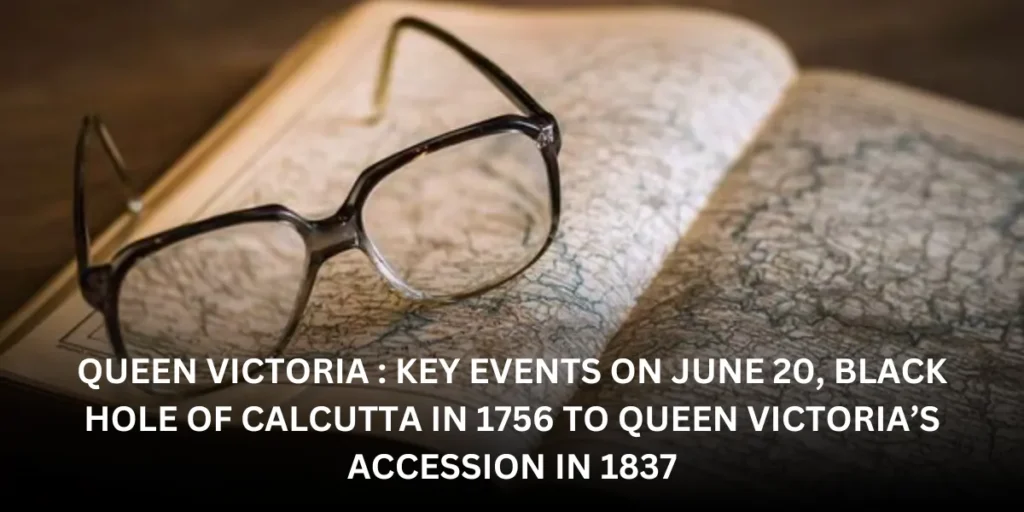Queen Victoria A number of noteworthy historical occurrences have occurred on June 20, including the devastating “Black Hole of Calcutta” in 1756 and Queen Victoria’s ascension to the British throne in 1837. Let’s explore these historical turning points.
Throughout history, June 20th has been associated with significant events that have had a lasting impact on society. This article examines significant events from the “Black Hole of Calcutta” to Queen Victoria’s ascent, ranging from terrible tales to victories.

The Black Hole of Calcutta: 1756
The Tragic Incident
Queen Victoria Early British colonial rule in India began in 1756 when Siraj-ud-Daulah, the Nawab of Bengal, took control of Fort William in Calcutta. This resulted in a horrific event in which approximately 146 people—the most of whom were British—were imprisoned in a small, inadequately ventilated chamber known as the “Black Hole.” There were very few survivors among the many inmates who perished due to the intense heat and lack of air. This incident represents the struggle for dominance in colonial India.
Queen Victoria’s Accession: 1837
A New Era Begins
After her uncle, King William IV, passed away on June 20, 1837, eighteen-year-old Queen Victoria took the throne in Britain. During her more than sixty-year rule, the Victorian era—known for its advancements in science, industry, politics, and culture—came to an end. The legacy of Victoria is still present in contemporary British society and culture.
The Great Seal of the United States: 1782
Symbol of Sovereignty
The United States started work on developing its official seal in 1776, following the adoption of the Declaration of Independence. The Continental Congress completed and accepted the design on June 20, 1782. Used on official documents, the Great Seal of the United States symbolizes the country’s sovereignty and attests to its enduring significance.
Muhammad Ali’s Conviction: 1967
Standing Against Injustice
The legendary boxer Muhammad Ali was found guilty in Houston in 1967 of refusing to be recruited into the military during the Vietnam War on the grounds that he opposed the conflict and had religious convictions. He was given a five-year prison sentence, but his case was taken to the US Supreme Court, which reversed it in 1971, reinforcing his opposition to social and racial inequality.
Obama Administration Benefits for Same-Sex Couples: 2014
Equality and Recognition
Significant progress was made in 2014 for same-sex couples nationwide during the Obama administration. New benefits, including as Social Security and veterans’ benefits, were extended to same-sex couples despite legal obstacles in some states, which was a crucial step towards equality and the acceptance of LGBTQ+ rights.
Conclusion
June 20th is a day to reflect on the world’s history, both its tragedies and its victories. Every significant incident, from the terrifying “Black Hole of Calcutta” to Queen Victoria’s revolutionary reign, speaks to larger issues of justice, power, and the development of society.
FAQ
What role did the Black Hole of Calcutta play?
Tragically, the Black Hole of Calcutta caused a great deal of death by bringing to light the violence and conflicts that existed in India during British colonial authority.
How much time did Queen Victoria rule for?
From 1837 until her death in 1901, Queen Victoria ruled for more than 63 years, making her one of the longest reigns in British history.
What led to Muhammad Ali’s 1967 conviction?
Muhammad Ali was found guilty of refusing to enlist in the military during the Vietnam War because he opposed the conflict and had strong religious convictions.
What advantages did same-sex couples receive in 2014 from the Obama administration?
Even in places where homosexual marriage was illegal, the Obama administration provided same-sex couples with benefits like Social Security and veterans’ benefits.
What led to the creation of the Great Seal of the United States?
The Great Seal of the United States was approved on June 20, 1782, and it was modeled after the Declaration of Independence. It represents the sovereignty and unification of the country.

